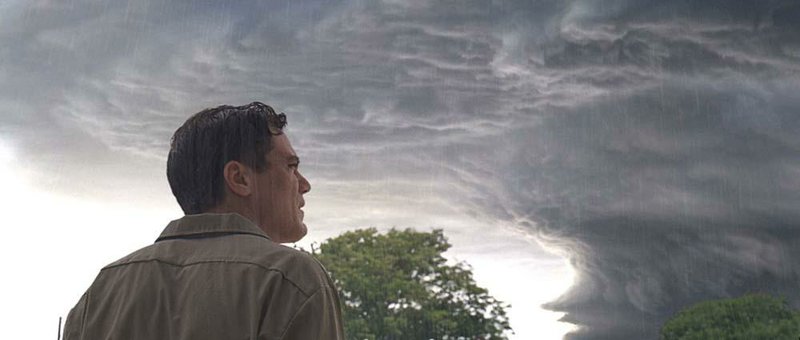LITTLE ROCK — Fear is the American vice, as well as the only thing most of us actually need fear. Every age is an age of anxiety, and Jeff Nichols’ Take Shelter latches on to something deep and true within many of us.
It is a movie of plausible horrors and tender moments, the sort of film that - if you are susceptible - can fill you up with inchoate feelings, unexplainable longings and phantom pains. It is the sort of movie to make you hug those you love, and to shiver at the whispers of the secret sharer - what the Showtime serial killer Dexter calls the “dark passenger” - within.
While several degrees more modest than Terrence Malick’s ambitious The Tree of Life, which sought to implant memories in its audience, Take Shelter is just as rigorous a work of art, albeit one disguised as a thriller. It is a fable rooted in the common dirt of semi-rural everywhere (specifically Ohio). But Take Shelter is immediately intelligible as a story about a worried man.
Curtis (Michael Shannon) seems to have reached the higher echelon of the American working class; he’s a supervisor for a sand-mining operation and lives in the sort of acceptably boring three-bedroom, bath and-a-half ranch house with which most of us are familiar (though they seldom appear in movies). He has a wife, Samantha (Jessica Chastain), who supplements the family income by selling her crafts at weekend flea markets, and a lovely daughter, Hannah (Tova Stewart), whose deafness might be mitigated by a cochlear implant.
But like many Americans, Curtis is uneasy; he is having nightmares - apocalyptic visions of murderous storms that rain viscous fluids. He feels slow-moving but dangerous things closing in on him; he dreams of betrayal and zombies. He cannot shake these intimations of dread, though he mostly understands that they are fantasies. But the brain does not distinguish the vividly imagined from the actual. His dog bites him in a dream, and he experiences the pain all the next day. And so he pens up the family pet, and later, gives him away.
Curtis’ tribulations are intensified by his childhood trauma - when he was 10 years old his mother, Sarah (Kathy Baker), went mad and was placed in an institution. Curtis knows her history, and he suspects the same plight is befalling him. He visits her to scan her face for answers, to compare notes - maybe to pay respects - but above all he means to protect his family.
To this end, he busts open the old storm cellar in his backyard and begins to make major improvements to it. As he undertakes this project, he understands that he is placing his family in financial jeopardy - his renovations are financed through a second mortgage on the family home and realized through the risky “borrowing” of some of his employer’s equipment - but he cannot help it. He “knows” something is coming.
And, as usual, something does. Exactly what that something is, Take Shelter doesn’t make entirely clear. Maybe Curtis is afflicted, maybe he’s a prophet, maybe he’s a carrier of a contagious schizophrenia. I don’t care. And while some people may feel a little cheated by the ending, I’m not sure it could have ended any other way.
It is technically a nearly perfect movie, with the special effects syncing neatly with Adam Stone’s wide-sky cinematography and what will likely be nomination-grabbing performances from Shannon and Chastain; it is the latter’s Samantha who provides the story with a combative heart as she tries to stand by her increasingly erratic husband, a good man fissured by doubts and on the verge of coming apart. If there is a hero here, it is Samantha, who fights to understand and cherish the incredibly shrinking Curtis. While Shannon does his usual excellent job of projecting emotional disintegration, there is a subtler terror in Chastain’s ocean green eyes as she struggles to hold on to him, to pull him back to the illusion of safety, to the life raft of family.
It’s beautiful. And powerful, and it comes at a time when a lot of us are subject to the kind of uneasiness that afflicts Curtis and Samantha - when a lot of us feel as though we’re but a paycheck or two away from bad things happening. When a lot of us fear the one we love could disappear.
Maybe I have not made Take Shelter sound like a movie anyone would want to see. That is not what I mean to do, it is not all frou-frou and arty and introspective. It is real and vital, clean and forceful, the disciplined work of a young master. It is the best sort of movie, neither escapist fantasy nor deeply personal tone poem (though those can be great), but a well-told story freighted with ideas that matter to a mass audience.
Sometimes I think we need to be reminded what movies can be, instead of what they usually are: entrepreneurial ventures designed to take advantage of human restlessness and our need to be entertained. We need to be reminded that a movie can teach us things about ourselves, that a movie can inform our condition and tell otherwise hard-to-get-at truths about what it means to live in the world we’ve made, with the people we’ve pulled around us, who we want so desperately not to hurt.
MovieStyle, Pages 33 on 10/28/2011
